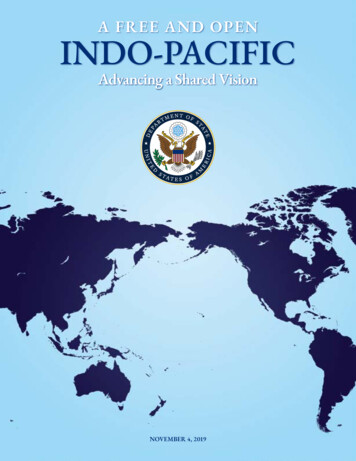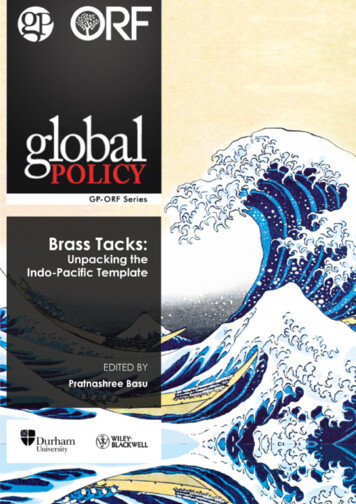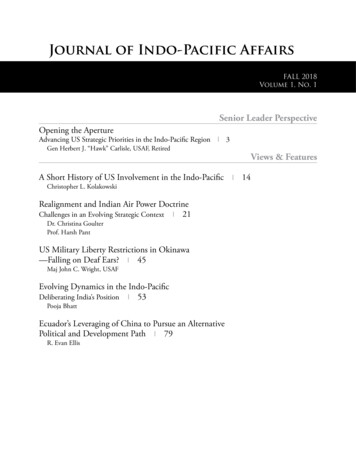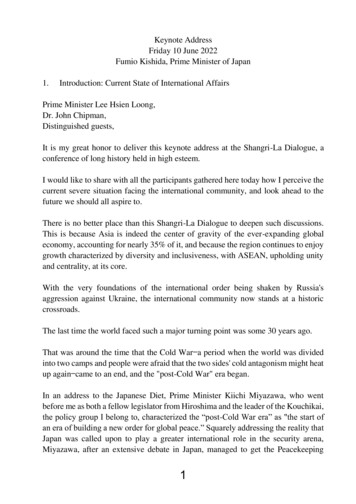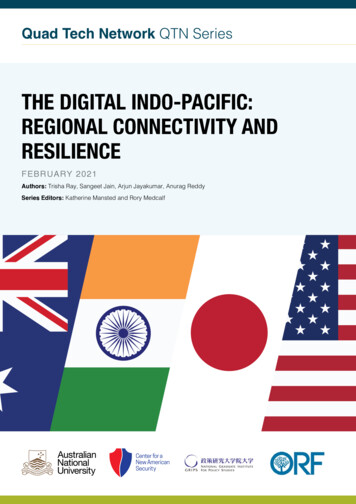
Transcription
Quad Tech Network QTN SeriesTHE DIGITAL INDO-PACIFIC:REGIONAL CONNECTIVITY ANDRESILIENCEFEBRUARY 2021Authors: Trisha Ray, Sangeet Jain, Arjun Jayakumar, Anurag ReddySeries Editors: Katherine Mansted and Rory MedcalfI
About the Quad Tech Network SeriesThe Quad Tech Network (QTN) is an Australian Government initiative to promote regional Track 2 research and public dialogue oncyber and critical technology issues.This paper is part of a series of papers by universities and think tanks in Australia (the National Security College at The AustralianNational University), India (the Observer Research Foundation), Japan (the National Graduate Institute for Policy Studies) and theUnited States (Center for a New American Security).The QTN series offers analysis and recommendations on shared challenges facing Australia and Indo-Pacific partners across fourthemes: international peace and security connectivity and regional resilience human rights and ethics, and national security.The QTN is managed by the National Security College at The Australian National University, with the support of the Australian Department of Foreign Affairs and Trade.About the Series EditorsRory Medcalf is Head of the National Security College at The Australian National University. Professor Medcalf’s professionalbackground spans diplomacy, journalism, think thanks and intelligence analysis, including as founding Director of the International Security Program at the Lowy Institute from 2007 to 2015. Professor Medcalf has been recognised as a thought leader internationally for his work on the Indo-Pacific concept of the Asian strategic environment, as articulated in his 2020 book Contest for theIndo-Pacific (released internationally as Indo-Pacific Empire).Katherine Mansted is the Senior Adviser for Public Policy at the National Security College at The Australian National University,and a non-resident fellow at the Alliance for Securing Democracy at the German Marshall Fund of the United States. She regularlywrites and presents to government and public audiences on technology and security policy. Ms Mansted holds a Master in PublicPolicy from the Harvard Kennedy School of Government, and a first-class degree in law and international relations.Copyright 2021 Observer Research FoundationPublished by the National Security College, The Australian National University, Acton ACT2601, AustraliaAvailable to download for free at nsc.crawford.anu.edu.auCover design and layout by Black Bear Creative.II
About the AuthorsTrisha Ray is an Associate Fellow at the Observer Research Foundation (ORF) Technology and Media Initiative. Her researchfocuses on geotech, the security implications of emerging technologies, AI governance and norms, and lethal autonomous weapons systems. Trisha is also a member of the UNESCO’s Information Accessibility Working Group. Prior to this, Trisha was a Program Assistant at the Asia Society Policy Institute in Washington DC, where she researched and wrote on national AI strategies inAsia, nuclear issues, and India–US security relations. Trisha completed her MA in Security Studies at the Walsh School of ForeignService at Georgetown University.Sangeet Jain is a Junior Fellow at ORF, working with the Centre for New Economic Diplomacy and the Technology and MediaInitiative. Her research focus is on employment and the future of work. Sangeet tracks India’s structural transformation and thechallenges of production in the digital age. Sangeet obtained her MPhil from the University of Cambridge.Arjun Jayakumar is an Associate Fellow at ORF’s Technology and Media Initiative. Before joining ORF, Arjun was associatedwith Software Freedom Law Centre, India, where he wrote extensively on issues affecting digital civil liberties and represented theorganisation at domestic and international policy forums. He has also published research reports on intermediary liability, communications surveillance, and online harassment.Anurag Reddy is a Research Assistant working with the Centre for New Economic Diplomacy and the Technology and MediaInitiative at ORF. Anurag tracks the latest developments in India’s innovation economy, including advances in India’s adoptiondigital public infrastructure and governance frameworks. Anurag completed a Masters in Liberal Studies (International Relations)at Ashoka University and holds a bachelor’s degree in Electronics and Communication Engineering from BITS Pilani. He was alsoa recipient of the Young India Fellowship.About the Observer Research FoundationFounded in 1990, the Observer Research Foundation (ORF) aims to encourage voices from all quarters, geographies, and gender,both those that fall in and those that question dominant narratives. It is this plurality of thought and voice – in a country of over a billion individuals – that ORF seeks to carry abroad, while simultaneously bringing contemporary global debates to India. ORF todayplays a seminal role in building political and policy consensus that enables India to interact with the world.For more information, please visit https://www.orfonline.org/III
The Digital Indo-Pacific: Regional Connectivity and ResilienceContentsIntroduction: The Digital Indo-Pacific1Minerals and Technology Manufacturing2Global Supply and Value Chains2Rare Earths3Semiconductors4Key Takeaways6Digital Economy and Adoption7Driving Factors: Digital Economy and Start-up Ecosystems7Investments in the Digital Indo-Pacific9Comparing Investments9The 5G ConundrumInclusive Digital Transformation1012Inclusive, High-quality Internet Access12Capacity13Capabilities15Key Takeaways17Regimes19Privacy and Data Protection19Data Localisation20Innovation Ecosystem20Trade Agreements21Conclusion and Recommendations23Annexure26Endnotes30IV
Quad Tech Network QTN SeriesIntroduction: The Digital Indo-PacificThe aim of this paper is to lay a foundation for inclusive collaborationtoward a Digital Indo-Pacific, which accounts for the differing butcomplementary strengths present in the region.At its heart, the Indo-Pacific is a term with its roots in the maritimerealm, a confluence of security, economic, and geopoliticalinterests linked to free and open movement between the Pacificand Indian Oceans.A relatively new entrant in geopolitical nomenclature,the ‘Indo-Pacific’ has since expanded to capture severalideas: the rule of law, balancing against China’s rise,strengthening regional institutions, and, most recently,securing technology and information flows.However, the Indo-Pacific also reflects distinct aspirations amongstthose who use it. The United States’ framing, being militarily driven,ends at the west coast of India with the US Indo-Pacific Command.1India’s conception, driven by its broader political-economic vision,stretches from the horn of Africa to the western Pacific.2The emergent Digital Indo-Pacific concept is linked to four factors.First, the region is home to the largest, most rapidly growing internetuser bases in the world. The region accounts for a little over half ofthe world’s internet users, and these users are primarily young andmobile: over 90 per cent access the internet using their phones.3The vibrant digital ecosystem is buoyed by booming e-commerceand fintech applications and an engaged and wired user base:Thailand, Philippines, Indonesia, Malaysia and India spend themost time online on their phones in the world.4Second, there has been a search for regional and domesticalternatives as the US–China trade war escalates due to theuncertainties created by the US-China trade war during the Trumpadministration. While some countries in the region are holding ontoa semblance of balancing their ties with both countries, severalare shifting decades-old stances to adapt to changing dynamics.For some, this has taken the form of enhanced investment intodomestic technology cap-acity-building, investment in R&D andin skilling and education. The Quad has also gotten a new leaseon life and, in October 2020, the foreign ministers of Japan,Australia, India, and the United States met to discuss ‘securedigital connectivity’.5Third, exposed by the trade war and heightened by the pandemicis the essentiality and fragility of global technology flows. Withgovernments, businesses and individuals forced to rely on onlinemeans for continuity, there is both a greater appreciation of theimportance of digital spaces, services, and goods as well asgreater scrutiny of bottlenecks created by ‘efficient’ global supplyand value chains.It is within this milieu that this paper seeks to analyse regionalconnectivity and resilience. The four sections of this paper –Minerals and Technology Manufacturing; Digital Economy andAdoption; Inclusive Digital Transformation; and Regimes – representa ‘four-layer’ framework for analysis.Connectivity encapsulates technology trade, access to onlineservices (where access is a spectrum, not a binary), as well asinteroperable regimes, including data protection and cybersecurity.Resilience, meanwhile, has been defined various ways, withvarying levels of detail. K.A. Foster defined regional resiliencesimply as ‘The ability of a region to prevent, prepare, respondand “recover” after a disturbance so as not to stand this obstacleto its development’.6 Oksana Palekiene added further nuance tothis description, calling it the ‘[c]apacity of a region to withstandand recover from external pressure or shock in order to maintainregion’s growth path close to potential or, if it is necessary, toreorganize its structure and transit to the new growth path’.7 For thepurpose of this paper, regional resilience is defined as the abilityof the region to withstand and recover from shocks generated bypolitical, regulatory, and economic action by one or more majorpartners. This is represented in the following ways: diversification,domestic capacity, and strength of regulation.This paper analyses seven countries – India, Australia, Singapore,Vietnam, Cambodia, Indonesia, and Malaysia – all representingdifferent systems of governance, demographic drivers, levels ofmaturity of digital ecosystems, and economic models.Finally, the Conclusions and Recommendations section pullsout a few key observations based on the research and identifiespathways for collaboration condensed into 10 recommendations.1
The Digital Indo-Pacific: Regional Connectivity and ResilienceMinerals and Technology ManufacturingGlobal Supply and Value ChainsDifferent countries have adopted different strategies to positionthemselves in this arena. Singapore’s Lee Hsien Loong’s measured ‘Asia-Pacific countries do not wish to be forced to choosebetween the United States and China’ is emblematic of the region’s hesitation to label either country a threat outright, due to theeconomic, institutional, and security benefits of ties with both.12While the jury is out on the precise trade-off between the national security imperatives of import and export controls, and thecompetitiveness of a country’s technology industries, countrieshave been re-evaluating their trade interdependencies under thelooming shadow of the US–China ‘decoupling’.8The pandemic, while not a driving factor, has seen the intensification of scrutiny of the risks of global supply and value chains. Thetrend toward ‘regionalisation’ and indigenisation will continue in thecoming decade. What then are the strengths and weaknesses ofthe region in the physical components that go into technologies?Global value chains (GVCs) account for nearly 50 per cent ofglobal trade.9 However, while GVCs grew rapidly in the 1990sand early 2000s, riding a wave of liberalisation and globalisationpolicies, they plateaued after the 2008 global financial crisis andare now likely to crunch due to what the World Bank characterisesas growing ‘disenchantment with free trade’.10Of the seven countries under study in this paper, three are netimporters (Australia, India, Indonesia) and four are net exporters(Cambodia, Malaysia, Singapore, and Vietnam) of computerhardware.13 This section will use components for smartphonesas a proxy for where the countries in this study are placed intechnology GVCs and whether they are able to develop andexploit their resources. The components studied are rare earthsand semiconductors.N. Chandrasekaran, co-chair of the US-India CEO Forum highlighted this shifting equation: ‘the global supply chain is gettingredesigned, redefined because supply has always been created for efficiency. Now the recent incidents, the pandemic, thegeopolitical situation, and trade issues have stressed the importance of having a supply chain that is rebalanced, resilient andnot only efficient.’11Net imports (USD millions)6,0004,000Net exports (USD iaIndonesiaMalaysiaSingaporeVietnamFigure 1: Hardware (HS8471) imports and export in USD millions (data extracted from Comtrade)2
Quad Tech Network QTN SeriesAll smartphones consist of the following components: an integratedcircuit or a ‘system-on-a-chip’; the sensors (for touch, light, motionetc); the screen (usually LCD); a battery; camera; and speaker.14The globalisation of supply chains and the ‘slicing of the valuechain’ over the past decades means that ‘firms across advancedand developing countries add value along these global supplychains by completing a specific task associated with the productionof a finished product and then exporting it’.15 The supply chain ofa smartphone typically spans several countries and hundreds ofsuppliers. Therefore, net ‘exporters’ of electronics like Vietnamand Malaysia are part of a regional value chain and are heavilydependent on components from China, and usually fulfil basicassembly roles. South Korean ICT giant Samsung, for instance,operates smartphone factories in Northern Vietnam but sourcesits electronics components from China.16This section focuses on rare earth elements (REEs) and semiconductors as basic indicators of dependency and potential to ‘moveup’ the GVC for electronics. Subsequent sections will delve intothe innovation ecosystems of these countries, including skills,R&D, and regulation.Rare EarthsRare earths elements (REEs) are a group of 17 elements thathave become increasingly strategically relevant in the digital age.Rare earths are used in components for televisions, electric cars,smartphones, and medical imaging, among many others.17 AllREEs are not equal: their differing properties lend them to differentend uses. For instance, lanthanum goes into the manufacturing ofalloys and batteries; europium and yttrium are used for computerand TV screens; and neodymium is used in petroleum refiningand electric vehicles.18Global consumption of rare earths is expected to double over thenext decade, driven primarily by growth in consumer electronics(especially mobile phones) as well as ‘green tech’ such as electricvehicles.20 While China dominates the production of rare earths,there is no dearth of global reserves, so while it accounts for 63per cent of mine production, it accounts for only 36 per cent ofglobal reserves. Among the countries in this study, Australia,Vietnam, and India possess significant reserves of rare earths.21The drive to diversify away from China has also taken the UnitedStates to Africa. The Pentagon’s Defense Logistics Agency is,for instance, conducting outreach to REE miners in Sub-SaharanAfrica,22 and South Africa has unearthed REE reserves with someof the highest concentrations in the world.23The production of rare earths is, however, steeped in start-upand long-term hidden costs. Surveying, extraction, chemicalprocessing, and management of rare earths incur significantexpenses, especially since rare earths are not found in concentrated pockets, making their extraction a tedious and dangerousprocess.24 The separation process typically uses concentratedacids, which – in the absence of proper waste management andenvironmental regulations – result in erosion and water contamination. Additionally, REEs are often found in conjunction withradioactive elements like thorium and (to a lesser extent) uranium,meaning that processing of REEs often generates slightly radioactive waste.25 If the experience of the Democratic Republic ofCongo, which supplies over 60 per cent of the world’s cobalt, isanything to go by, mining of lucrative minerals in the absence ofstrong institutional, legal safeguards will result in environmentaldegradation and human rights abuses.26 It is critical, therefore,that as new geographies enter the REE supply chain, they doso in a way that is sustainable, low-impact and backed by thenecessary legal regimes.AustraliaDemandProjected400K metric tones20001965Source: BloombergNEFFigure 2: Global consumption of REEs192030Australia began producing REEs in 2013, rapidly scaling up tobecome the world’s second-largest producer by 2019. A handfulof companies are undertaking feasibility studies for further mining projects, which could add a further 1.6 kt/year of productioncapacity.27IndiaIndia was a relatively early entrant in the REEs market. Indian RareEarth Limited (IREL), a public sector enterprise, was establishedin 1950. However, rare earth mining was halted between 2004and 2011 due it being economically unfeasible and was replacedby cheaper REE imports from China.28 Following the tighteningof REEs exports by China in early 2011, IREL resumed its miningoperations, backed by a partnership with Japan’s Toyota Tsusho.29In India, monazite is the principal source of REEs, and while ithas abundant reserves of REEs, its potential remains untapped.303
The Digital Indo-Pacific: Regional Connectivity and ResilienceWhile it accounts for around 2 per cent of global production,India is home to 6 per cent of global reserves. Additionally, theGeological Survey of India (GSI) is researching cost-effectiveextraction methods and exploring the feasibility of extractingREEs from Arabian Sea sediments.31VietnamVietnam is home to the world’s third-largest reserves of REEs.Vietnam, like India, was a beneficiary of China’s restrictions onREE exports, having received significant investments from Japan,South Korea, and Australia. Vietnam Rare Elements Chemical, ajoint enterprise with Japan’s Keita Kodama, for instance, begana production project in 2014.32 Vietnam’s Mineral ResourcesStrategy 2020, lays out further plans for exploration of rare earthmines and establishing international partnerships for exploration,mining, and processing of REEs.33SemiconductorsSemiconductors are a class of crystalline solids – such as siliconand gallium arsenide – whose conductivity lies between that ofconductors and insulators, hence the term.34 The semiconductingmaterial to look out for in the future is gallium nitride (GaN), whichmay see growing importance as a component of 5G cell sites.Mobile semiconductors, meanwhile, are expected to grow at aCAGR of 7.49 per cent between 2020 and 2025, although economic slowdown in the wake of the pandemic will likely mutethis growth.37Going through the life stages of semiconductor manufacturingprovides key insights into a country’s place in GVCs. Quartz andsilica sands, for instance, are one of the fundamental raw materialsthat eventually go into semiconductors. The United States is theworld’s largest exporter of silica sands (36.1 per cent), followedby Australia (11.2 per cent). Silica sands are, like rare earths,fairly abundant but also environmentally hazardous to extract.Silica sands are refined to obtain silicon dioxide. The majorexporters (in terms of value in USD) are China (22.8 per cent),Germany (17.4 per cent), and Japan (9 per cent), while majorimporters are United States (8.41 per cent), Germany (7.14 percent), and China (6.98 per cent).38The world’s top 10 semiconductor foundries, also known as fabrication plants or fabs, are concentrated in Taiwan and China: Taiwan Semiconductor Manufacturing Company Limited(TSMC): Taiwan, ROC United Microelectronics Corporation (UMC): Taiwan, ROCSemiconductor devices are electronic circuit components thatare important components in electronic systems, including memory, processors, and sensors. While ‘semiconductor’ as a termis used for both the materials themselves as well as the devicesmade from them, the remainder of this section will use the termto describe the latter, unless stated otherwise. Globalfoundries: US Samsung Electronics: South Korea SMIC: China, PRC Powerchip Technology: Taiwan, ROC Towerjazz: IsraelThe global semiconductor market nearly quadrupled between1998 and 2020, growing from USD 125.6 billion to a forecastedUSD 426 billion.35 AI-related semiconductors alone are expected to grow at a CAGR of 50 per cent between 2019 and 2022.36 Fujitsu Semiconductor: Japan Vanguard International: Taiwan, ROC Shanghai Huahong Grace Semiconductor: China, PRCREE Mine ProductionRest of theworld 13%REE ReservesAustralia1%Australia10%China37%Rest of theworld 37%United States12%India2%China63%United States1%Vietnam18%Figure 3: Global REE production and reserves in 2019 (data from US Geological Survey)4India6%
Quad Tech Network QTN SeriesHowever, the biggest of these – TSMC, UMC, Globalfoundriesand SMIC – are all ‘pure play’ foundries, i.e. they do not designsemiconductors, but only manufacture them under contract.Hence, the final share of the semiconductor market is dominatedby firms based in the United States.As a result, the supply chain for semiconductors suffers from twomajor setbacks. First, two semiconductor vendors, Intel (US) andSamsung (South Korea), account for nearly half of global revenue. Second, the supply chains for semiconductors are heavilyspecialised – lean but brittle – characterised by ‘bottlenecks’that, if disrupted, risk the collapse of the entire chain. A handfulof countries – US, South Korea, Japan, Taiwan, and China – dominate different stages and components.40The twin pressures of the US–China trade war and the COVID-19pandemic have exposed many of these flaws in the supply chain,but also created opportunities for countries in the Indo-Pacificwhich are looking to reap the benefits of a semiconductor supply chain shift and are angling themselves as the next favoureddestination for semiconductor foundries.CambodiaCambodia’s electronics exports constitute around 3 per cent ofits total export value, and its place in the GVCs for semiconductors is restricted to assembly of electronic components suchas semiconductor wafers, integrated circuits, and bare circuitboards.41 Cambodia has been a recipient of Japanese investmentin electronics manufacturing: Khmer Semiconductor (founded2012), Cambodia’s first semiconductor manufacturing enterprise,is a joint venture with semiconductor manufacturers in Japan.42IndiaIndia is a massive consumer of electronics. In 2018, for instance,its electronics and machinery imports stood at USD 96.5 billion,or 19.6 per cent of its total imports. By 2025, the Indian semicon-Kioxia4%ST Microelectronics4%Texas Instruments6%NXP4%ductor component market alone is expected to reach USD 32.35billion.43 Today, India is home to a handful of semiconductor firms.For instance, the Bangalore-based SmartPlay Technologies specialises in semiconductor design, and Invecas provides assemblyand testing services, in partnership with TSMC and Globalfoundries.44 The Defence Research and Development Organisationestablished the Society for Integrated Circuit Technology andApplied Research with the aim of providing integrated circuitdesign for strategic and security systems.45The Government of India identified the need to build a domesticfab facility a decade ago. The then Department of Electronics andInformation Technology (DeitY) invited expressions of interest (EOIs)for the setting up of semiconductor fabs in 2011.46 Consequently,Hindustan Semiconductor Manufacturing Corporation (HSMC),a consortium of companies including ST Microelectronics andSilterra, was established with the aim of building the country’sfirst wafer fab in the state of Gujarat.47 The project has, however,faced several delays. India’s 2020 budget has given a fresh boostto this indigenisation effort with proposed schemes to incentiviseelectronic manufacturing in the country.48IndonesiaIndonesia’s semiconductor industry consists primarily of assemblyfacilities established by foreign companies such as Linde (Germany), which processes gas and chemicals for semiconductors,and Panasonic (Japan).49Recognising this gap, the Making Indonesia 4.0 strategy, releasedin 2018, outlines as one of its aims taking Indonesia’s electronicssector from low-tech assembly to high-tech, high-value exports.50It identifies reliance on imports for key components like semiconductors as a challenge. Concurrently, Jakarta is also looking toattract more semiconductor manufacturers to Indonesia, courtingcompanies from Taiwan and ronTechnology8%Samsung22%SK Hynix9%Figure 4: Global semiconductor market share (based on data from Gartner)395
The Digital Indo-Pacific: Regional Connectivity and ResilienceMalaysiaMalaysia houses operations of several global semiconductorcompanies and has also built its own enterprises including thestate-owned SilTerra, which offers both foundry and designservices, First Elterra and Symmid, both fabless semiconductorcompanies, as well as a host of pure play foundries.52The Malaysian Investment Development Authority (MIDA) hasbegun to offer incentives for design and development (D&D)activities in the electronic industry, including for ‘higher value’activities in integrated circuit design and packaging.53SingaporeMore than 200 semiconductor companies operate in Singapore– a mix of foreign-owned, joint ventures and home-grown companies, including both pure play foundries and fabless facilities.In 2019, the semiconductor industry constituted 7.8 per cent ofthe country’s GDP.54Even as its economy shrunk in 2019–20, hit by the US–China tradewar and the COVID-19 pandemic, the semiconductor industryin Singapore saw ‘stronger than expected demand’, buoyed bydemand based on 5G, cloud services, and data centres.55VietnamVietnam became a favoured destination of a wave of reshoringsfrom China to Vietnam for electronic manufacturing, and otherlabour-intensive industries starting in the mid-2000s, a trendaccelerated by the US–China trade war.56 In 2006, for instance,Intel announced plans to build a USD 300 million semiconductor assembly and test facility in Ho Chi Minh City and, in 2019,Seoul Semiconductor announced plans to move 60 per cent ofits production to Vietnam.57 The semiconductor market in Vietnamis forecast to grow by USD 6.16 bn during 2020–24 at a CAGRof 19 per cent.586Much of the semiconductor industry in the country is in ‘lowvalue’ assembly activities, such as the Intel plant. Consequently,in a bid to move up the value chain, the Vietnamese Governmenthas pushed for building domestic semiconductor fab capabilities, investing USD 300 million in the country’s first wafer fab inSaigon Hi-Tech Park.59 Between 2013 and 2020, the Ho Chi MinhCity Integrated Circuit Development Programme researched andpromoted investment in ‘minimal fab’, a low-cost, low-capital alternative to existing fab methods.60Key TakeawaysThe US–China imprint is prominent in REEs andsemiconductors. In REEs, China’s edge lies in the massivevolumes of investments poured into extraction andprocessing, a short-term cost that was untenable forIndia and Vietnam, both of which possess sizeableuntapped reserves.India, Australia, and Vietnam are, however, undertaking feasibilitystudies, re-opening defunct projects, and injecting investment intothis area in view of its increasing strategic importance.Most high-value activities like semiconductor design or integrated device manufacture (design and assembly) remain heavilyconcentrated in the United States. Consequently, the countriesunder study primarily specialise in ‘pure play’ foundries that supplyservices to semiconductor giants based outside their borders.Nevertheless, India is home to a handful of semiconductor designfirms, including those in the defence sector, and Singapore is amajor semiconductor manufacturing hub, with over 200 fablessand pure play manufacturers operating in the city-state. Malaysia,Indonesia, and Vietnam are all incentivising semiconductor manufacture and India too is off to a sputtering start on its ambitionto build a full semiconductor fab facility.
Quad Tech Network QTN SeriesDigital Economy and AdoptionThe Indo-Pacific region is home to some of the largest digitaleconomies in the world. The focus countries (India, Australia,Cambodia, Indonesia, Malaysia, Singapore, Vietnam) are home toa fifth of the world’s internet users, accounting for nearly 1 billionpeople online. The total size of the digital economies in the regionstands at nearly USD 400 billion, with India commanding half theshare,61 followed by Australia at USD 122 billion62 and Indonesia,Malaysia, Singapore, and Vietnam collectively at USD 75 billion.63In the Southeast Asia (SEA) region, Indonesia and Vietnam arepacesetters with annual growth rates at over 40 per cent.64SEA and India are witnessing a rapid growth in their internetuser bases. Indonesia and India have the fastest digital adoptiongrowth rates amongst 17 major digital economies in the world.65India has added over half a billion internet users since 2013 and,as of December 2019, the country has 718.74 million internetsubscribers.66 Furthermore, users in SEA and India spend asignificant time on the internet, and the average amount of timespent per day exceeds the global average.67 Indian mobile datausers consume an average of 10.4 GB of data each month,68and this is growing at an annual rate of 171 per cent – more thantwice the growth rates in United States and China.69 Internetspeeds in the region – both mobile and broadband – exceed 10Mbps,70 which is considered as the ‘minimum speed requiredfor consumers to fully participate in a digital society’.71 Most ofthe region’s users c
services (where access is a spectrum, not a binary), as well as interoperable regimes, including data protection and cybersecurity. Resilience, meanwhile, has been defined various ways, with varying levels of detail. K.A. Foster defined regional resilience simply as 'The ability of a region to prevent, prepare, respond


